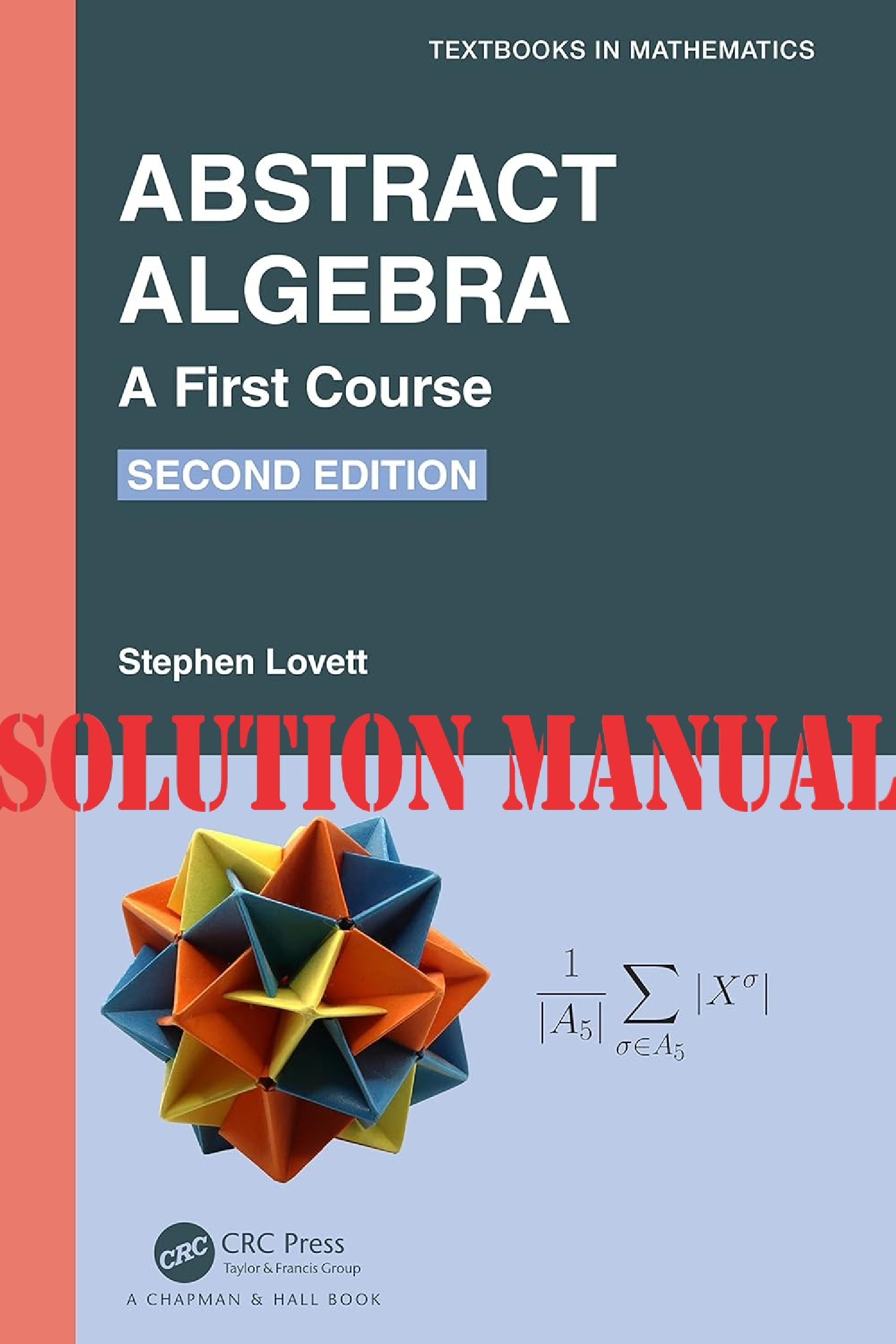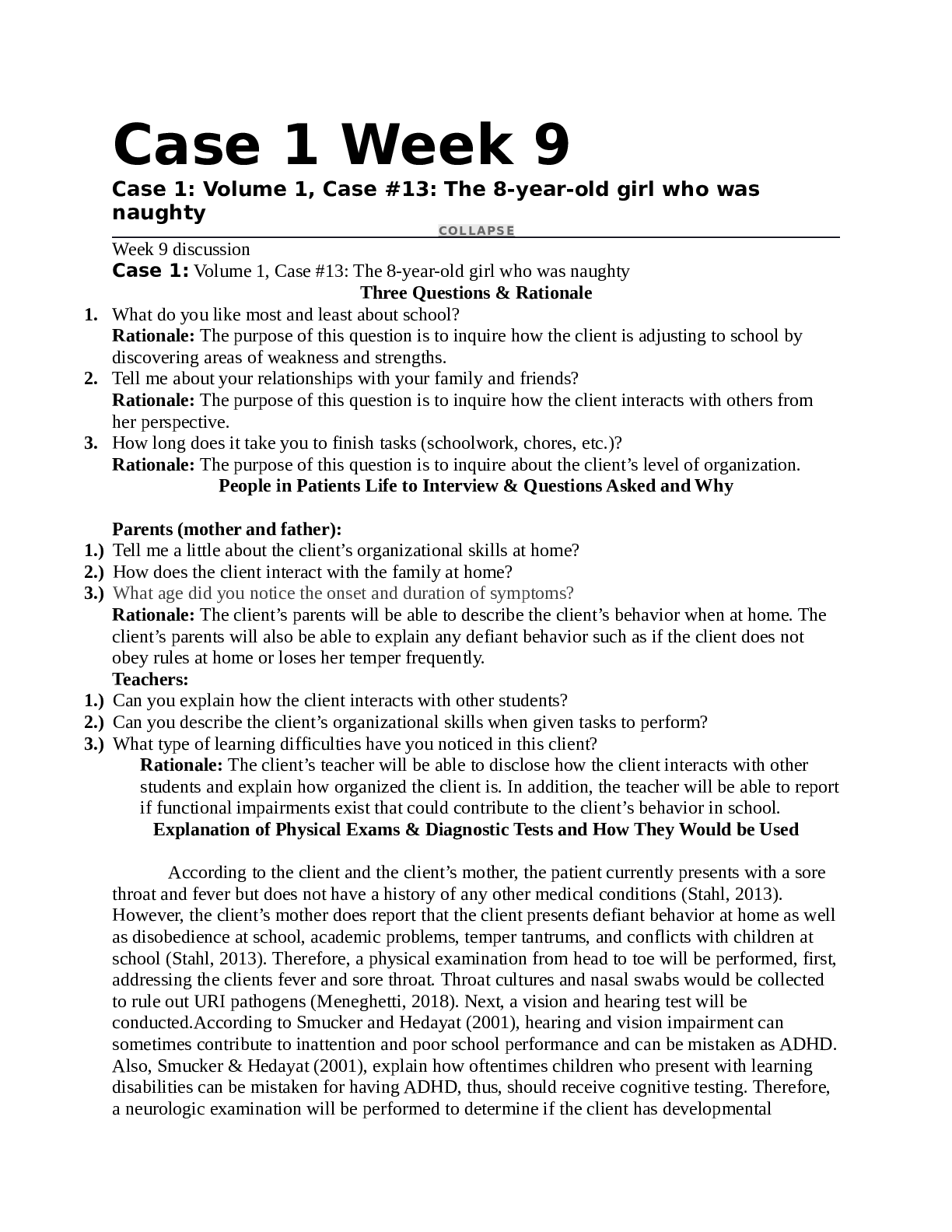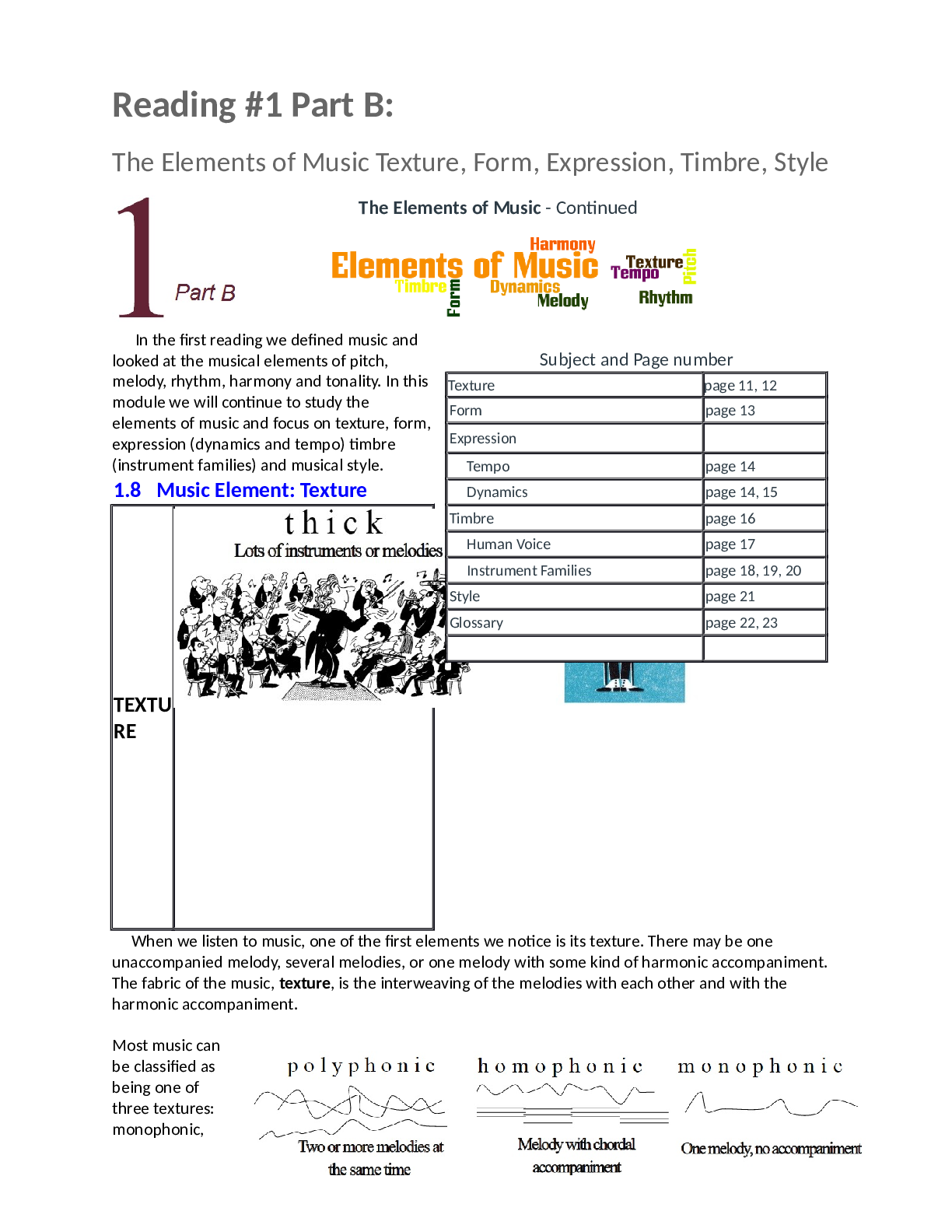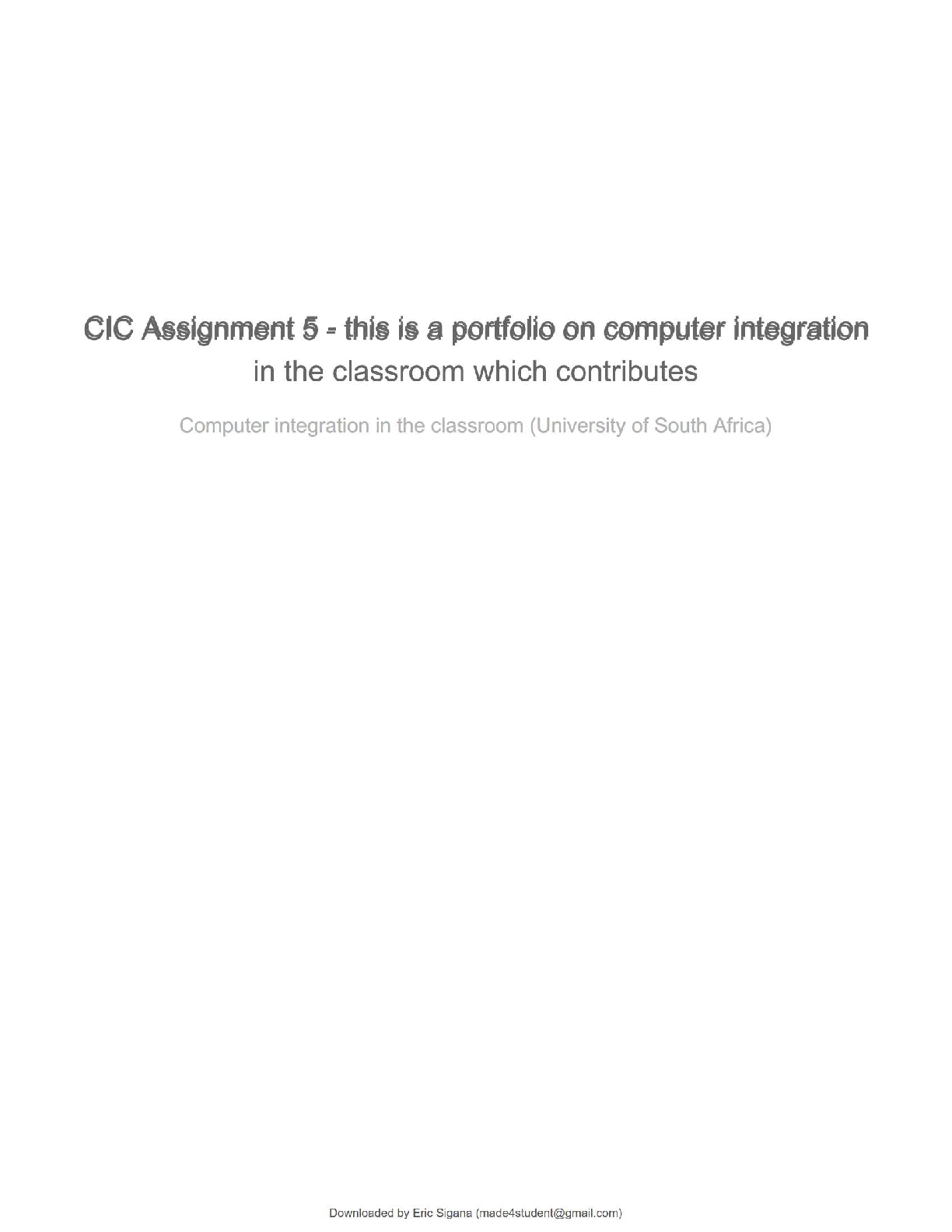MUSI 1002Reading 1B The Elements of Music. Reading #1 Part B: The Elements of Music Texture, Form, Expression, Timbre, Style
Document Content and Description Below
The Elements of Music - Continued
In the first reading we defined music and
looked at the musical elements of pitch,
melody, rhythm, harmony and tonality. In this
module we will continue to study
...
the
elements of music and focus on texture, form,
expression (dynamics and tempo) timbre
(instrument families) and musical style.
1.8 Music Element: Texture
TEXTU
REWhen we listen to music, one of the first elements we notice is its texture. There may be one
unaccompanied melody, several melodies, or one melody with some kind of harmonic accompaniment.
The fabric of the music, texture, is the interweaving of the melodies with each other and with the
harmonic accompaniment.
Most music can
be classified as
being one of
three textures:
monophonic,
Subject and Page number
Texture | page 11, 12
Form | page 13
Expression
Tempo page 14
Dynamics page 14, 15
Timbre page 16
Human Voice page 17
Instrument Families page 18, 19, 20
Style page 21
Glossary page 22, 23
homophonic or polyphonic. The root "phonic" means sound, such as in the words "telephone" or
"phonograph". The prefix "mono" means "one". Therefore "monophonic" means "one sound".
Monophonic Texture
Monophonic Texture - One pitch
sounding at a time with no
accompaniment or harmony.We call a piece of music monophonic when it is composed of a single melody played by itself. There
can be no other melodies or chords being played. Examples of monophonic texture occur when a singer
sings by his or her self, or when all the members of a musical group play the exact same melody at the
same time. This one melodic line may be sung by one person or 100 people. The important thing is that
they are all singing the same melody, either in unison or in octaves.
A whole piece of music in a monophonic texture is rare today, however, short sections of larger works
in a monophonic texture are not uncommon. In the Medieval period, however, most music was
monophonic.
VIDEO: Link (Links to an external site.)Links to an external site.
The following video is a modern example of a song with a monophonic texture. There is one note being
performed at a time with no harmonic accompaniment.
VIDEO: Link (Links to an external site.)Links to an external site.
Page 11 ______________________________________________________________________________
Homophonic Texture
Homophonic Texture - One
MELODY with some kind of
accompaniment.The prefix "homo" means "the same". Homophonic literally means "the same sound". In music, a
texture that combines a single melody with chords (harmony) is called homophonic. Someone singing a
melody while strumming chords on a guitar is a very common example of homophonic texture. We call
this homophonic because the combination of chords and melody creates such a smooth blend that the
chords and melody almost sound "the same".
A majority of rock and popular music is found with a homophonic texture where the melody is the
most important aspect of the song.
The following example is an example of a homophonic texture. The vocal has the melody and the
keyboard, strings guitar and drums provide the accompaniment.
VIDEO: Link (Links to an external site.)Links to an external site.
Here is another example of Billy Joel's Piano Man. You will hear mostly piano and voice with the voice
having the melody.
VIDEO: Link (Links to an external site.)Links to an external site.
Polyphonic Texture
Polyphonic Texture-Two or
more independent
MELODIES performed
simultaneously.
Polyphonic texture is the last texture we will study. "Poly" means “many"; polyphonic - "many
sounds". In music two or more MELODIES sounding at the same time make a polyphonic texture. The
important word is melodies. Two or more voices singing together in harmony do not create a polyphonic
texture. Don't confuse melody with harmony. A melody is independent and can stand on its own
without the support of any other music. Harmony is dependent on the melody. Without the melody a
harmony line makes no sense.
IMPORTANT!: Polyphonic textures can happen in a couple of different ways. In one way, a musician plays
one melody while at the same time other musicians play one or more completely different melodies.
A second way of creating a polyphonic texture is to have musicians play the same melody, but starting
at different times. For example, one singer might start singing the song "Row, Row, Row Your Boat". A
few notes later a second singer begins the same melody. The effect is like the game children play when
one child immediately copies (imitates) what another child does. In music we call this "imitation".
Imitation is the replaying in another voice or part a melody or other musical idea. Rounds and cannons
are two kinds of music which use imitation. In the music below, the same melody (indicated by the
bracket) enters three times, each time overlapping the previous statement of the melody thus creating a
polyphonic texture.
Below is an
example of
a polyphonic
texture. Notice
that the first :24
seconds have a
homophonic
texture but when
the second
MELODY enters
at :25 the texture
becomes polyphonic until :45. At that point the texture shifts back and forth from homophonic to
polyphonic. Thinking Out Loud / I'm Not The Only One MASHUP (Sam Tsui & Casey Breves)
VIDEO: Link (Links to an external site.)Links to an external site.
Here is another example of a polyphonic texture. This example also shifts textures back and forth. There
are two independent melodies performed simultaneously. Blank Space/Style (Taylor Swift Mash-Up)
VIDEO: Link (Links to an external site.)Links to an external site.
Page 12 ______________________________________________________________________________
1.9 Music Element: Form
FORMEvery piece of music has an overall plan or structure, the “big picture,” so to speak. This is called
the form of the music. Musical forms are based on the recognition of musical themes and motifs. When
we listen to a piece of music there is generally a recognizable primary theme (melody) that serves as the
building block for part or all of the composition. Listen to the opening theme of Star Wars.
VIDEO: Link (Links to an external site.)Links to an external site.
Another common compositional devise is to use motifs. A motif is a short, recognizable melodic and/or
rhythmic fragment used in a composition. The opening four notes of Beethoven's 5th Symphony are an
iconic example. Listen to the examples in this video.
VIDEO: Link (Links to an external site.)Links to an external site.
Musical forms offer a great range of complexity. Most listeners will quickly grasp the form of a short
and simple piece, or of one built from many short repetitions. It is also easier to recognize familiar
musical forms. The average American, for example, can distinguish easily between the verses and refrain
of any pop song, but will have trouble recognizing what is going on in a piece of music for Balinese
gamelan. Classical music traditions around the world tend to encourage longer, more complex forms
which may be difficult to recognize without the familiarity that comes from study or repeated hearings.
You can enjoy music without recognizing its form, of course. But understanding the form of a piece
helps a musician put together a more credible performance of it. Anyone interested in music theory or
history, or in arranging or composing music, must have a firm understanding of form. And being able to
“see the big picture” does help the listener enjoy the music even more.
Composers work with the elements of music and have virtually an infinite number of combinations
of pitch, melody, rhythm, tonality, timbre and expression. The element of form is associated with the
shape, structure and organization of these elements in time. Over the centuries many plans for
organizing music have evolved. These forms have developed from the trials and errors of hundreds of
composers over hundreds of years. Because music happens over time, memory plays an important role
in how we experience musical form. Memory allows us to hear repetition, contrast, and variation in
music. And it is these elements that provide structure, coherence, and shape to musical compositions.
A composer or songwriter brings myriad experiences of music, accumulated over a lifetime, to the act
of writing music. He or she has learned how to write music by listening to, playing, and studying music.
He or she has picked up, consciously and/or unconsciously, a number of ways of structuring music. The
composer may intentionally write music modeled after another group’s music: this happens all of the
time in the world of popular music where the aim is to produce music that will be disseminated to as
many people as possible. Music forms are not, however, molds waiting for composers to fill with notes.
Instead, music forms are usually structured around one or more of three general elements: repetition,
contrast and variation. It’s these elements that provide structure, coherence, and shape to musical
compositions.
[Show More]
Last updated: 3 years ago
Preview 1 out of 18 pages
.png)
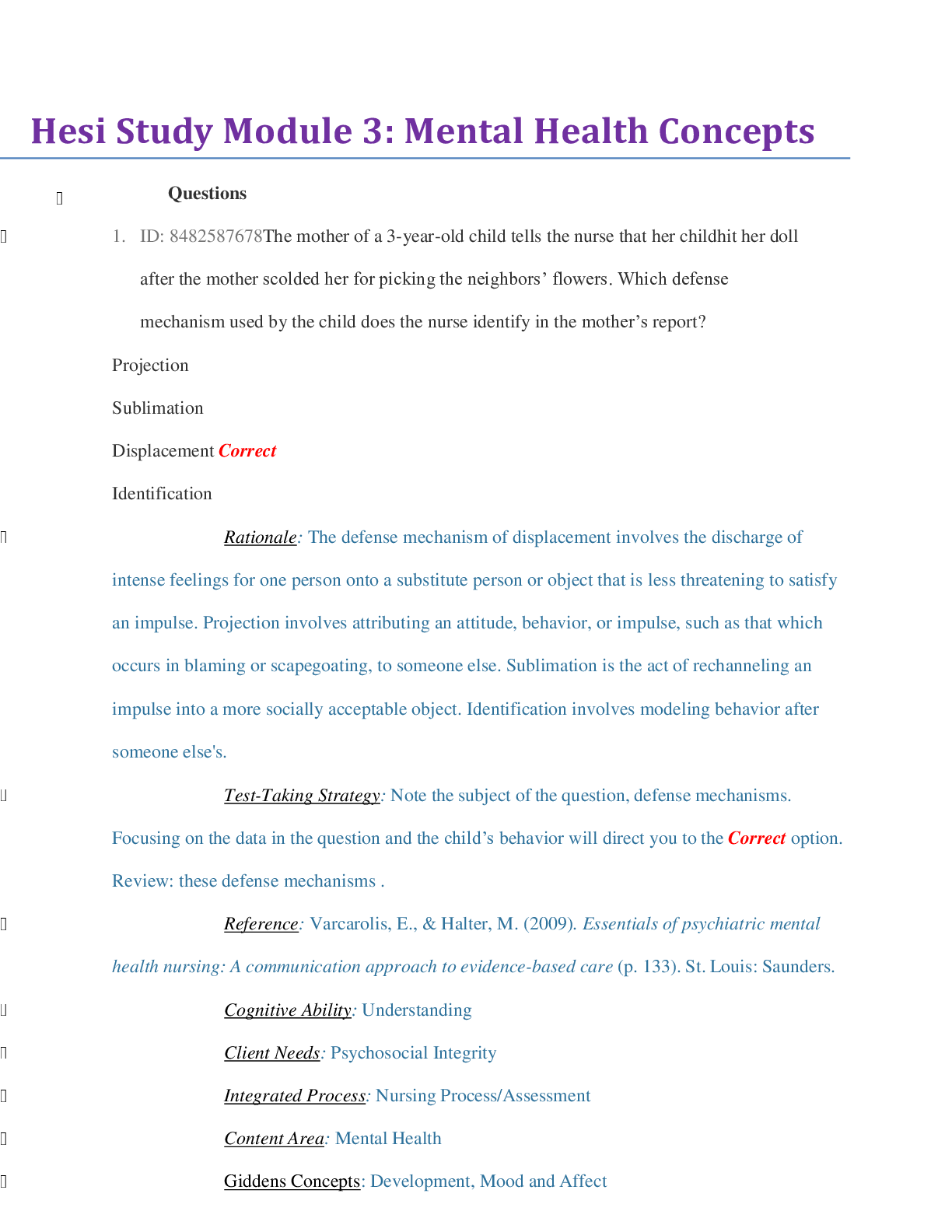
.png)


